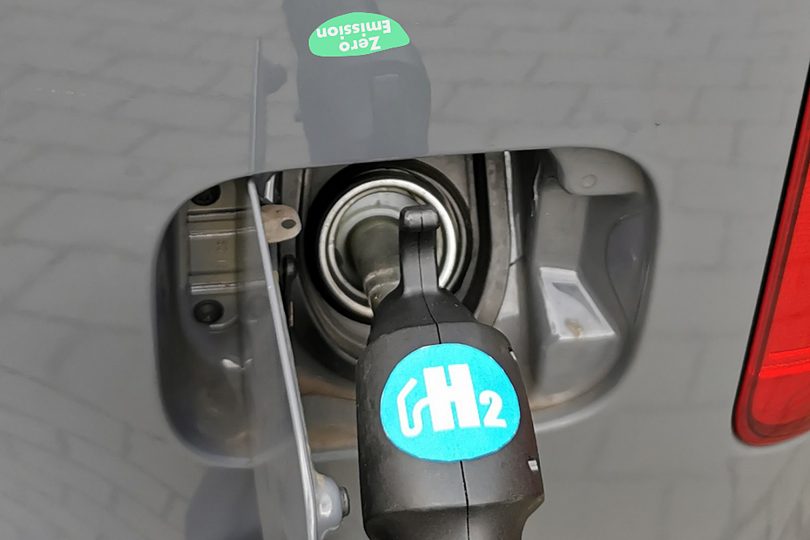Groundbreaking ceremony for the new Hydrogen Terminal at Braunschweig Research Airport Aim: Research into green hydrogen production technologies
An important step for the energy transition: On 23 March 2023, the starting signal was given for the construction of the Hydrogen Terminal Braunschweig (H2 Terminal) near Braunschweig Airport (hence the name “Terminal”). The research project is funded by the Federal Ministry of Education and Research (BMBF) with a total funding volume of over 20 million euros. The research project is being implemented as a joint project by the Steinbeis Innovation Centre energieplus (siz energieplus) and Technische Universität Braunschweig. TU Braunschweig is participating with seven research institutes and the Facilities Management division. Currently, about 15 employees at both institutions are working on the joint research project.
“With this research project, we have the opportunity to implement an energy centre of the future and make the energy transition tangible. Along the way, we are decarbonising part of the research and creating a nucleus for future projects and scientific work on the topic of hydrogen with the new research environment,” says David Sauss, head of siz energieplus and building owner.
Torsten Markgräfe, head of the Facilities Management division at TU Braunschweig, supports: “With this joint project, the participants are facing one of the biggest challenges of the energy transition, the transport and storage of renewable energies and their use in the heat and mobility sectors. A solution is emerging in conjunction with hydrogen technology.”
Prof. Bernd Engel, head of the elenia Institute for High Voltage Technology and Power Systems and spokesperson for the joint project at TU Braunschweig: “With the Braunschweig H2 Terminal, research is being conducted on a megawatt scale into how electrolysers and associated batteries can stabilise the power grid when conventional, fossil-fuel power plants are switched off.”
Research along the hydrogen efficiency chain
On the approximately 4,700 square metre site, comparable to the size of a smaller football field, in Gerhard-Borchers-Straße in Braunschweig, the research laboratory is being built as a demonstrator of a future energy centre in the megawatt range for the utilisation chain starting from renewable energies to green hydrogen.
The aims of the joint project are to bundle research expertise along the hydrogen efficiency chain and to realise research work on the topics of hydrogen production, storage, feed-in and distribution as well as reconversion in fuel cells. The construction of the terminal will bring both the hydrogen efficiency chain and sector coupling to life.
Electrolysers and electrolysis test stand
The centrepiece of the project is the multicore electrolyser from the company Enapter with a power class of 1 megawatt, which is the world’s first prototype to bring AEM (anion exchange membrane) technology to Braunschweig. In addition, a high-temperature electrolyser (solid oxide electrolysis cell, SOEC) for hydrogen production from water vapour will be used on the site. In addition to the electrolysers located outside the building, electrolysis test stands will be set up in the research building to cover alkaline electrolysis and PEM electrolysis (protone exchange membrane).
Direct comparison of the most important approaches to hydrogen production
With the four electrolysis technologies, the essential range of existing production approaches for green hydrogen is represented for direct comparison within the H2 terminal. Within the framework of the project, research is being conducted to increase the respective efficiency of all generation technologies. In addition, the possibility of generating hydrogen through (co-)pyrolysis of hydrocarbon feedstocks will be tested and further developed within the research project.
Green hydrogen – generated for further research at the NFF and Fraunhofer ZESS
The green hydrogen produced with renewable electricity from the electrolysers is fed into various forms of use. On the one hand, it is used in internal test stands to conduct ageing tests with different hydrogen qualities and thus decarbonises part of the research work. On the other hand, other external (fuel cell) test stands at the Fraunhofer Project Centre for Energy Storage and Systems (Fraunhofer ZESS) and at the Automotive Research Centre Niedersachsen (NFF) are supplied with the green hydrogen by pipeline.
Parallel to the hydrogen supply, Fraunhofer ZESS is supplied with processed electrolysis waste heat. For this purpose, the temperature level of the waste heat from the electrolysis processes is raised with the help of a high-temperature heat pump and made available via a local heating network. In addition to the use of hydrogen in the test stands, it is used on the NFF site to test hydrogen storage in what is currently the world’s largest metal hydride storage facility operated by the company GKN Hydrogen.
On the grounds of the H2 terminal itself, the hydrogen produced is used not only in test stands but also to operate a hydrogen filling station from the manufacturer Maximator. At this station, heavy-duty vehicles can be refuelled with green hydrogen at a pressure of 350 bar.
Furthermore, it is being investigated how the electrolysers and the fuel cells, together with a large battery storage system (storage capacity 1.1 megawatt hours from the company SMA) and the solar system (installed capacity 150 kilowatts), can be used to stabilise the grid when conventional fossil power plants are no longer available.
Research areas siz and institutes TU Braunschweig:
- Steinbeis Innovation Centre energieplus – siz: decoupling, processing and distribution of electrolysis waste heat, H2 logistics, increasing electrolysis efficiency, further development of methane pyrolysis for hydrogen production
- elenia Institute for High Voltage Technology and Power Systems: Grid and system integration of electrolysers and other components
- Institute for Building Climatology and Energy of Architecture – IBEA: Climate neutrality and economic energy integration
- Institute of Energy and Process Systems Engineering – InES: Dynamic Simulation of Electrolysers
- Institute of Urban Design- ISE: Adaptation of the Campus Development Master Plan
- Institute of Technical Chemistry – ITC: Ageing diagnostics of electrolyzers
- Institute for Internal Combustion Engines – ivb: Fuel cell systems and drives
- Institute of Machine Tools and Production Technology – iWF: Overall system modelling and holistic evaluation

